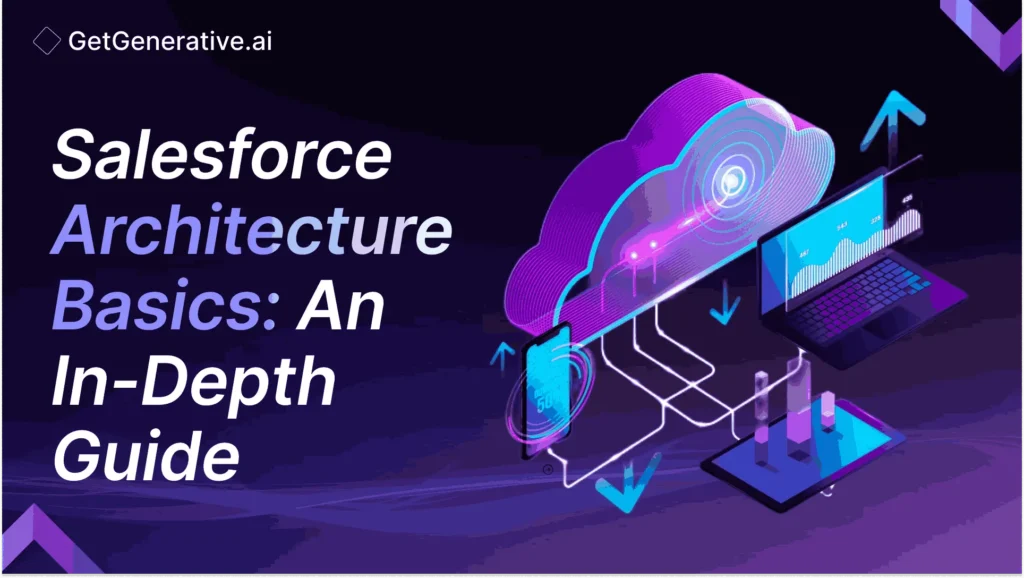Salesforce Architecture Basics: An In-Depth Guide 2024
Salesforce, a leading cloud-based platform, provides robust capabilities for businesses to manage customer relationships and business processes. Central to its efficiency is the Salesforce Customer 360 Platform, which boasts a multitenant, metadata-driven architecture. This architecture underpins the various functionalities and is crucial for developing solutions on the platform.
This blog delves into the fundamental aspects of Salesforce architecture, focusing on transactions, the distinction between metadata and data, and the extensive platform APIs.
Understanding Transactions in Salesforce
A Salesforce transaction encompasses both code execution and database operations. The platform enforces specific limits, referred to as governor and execution limits, to ensure equitable resource distribution among tenants. These limits are critical in preventing any single transaction from monopolizing system resources.
Execution Context
Salesforce defines transactional limits based on an execution context, which includes all code executed within a tenant’s environment. This context is not limited to custom code but extends to code from installed packages and Salesforce platform services. Understanding the distinctions in how Apex code is governed within this context is vital for optimizing performance and compliance with platform limits.
Database Manipulation
Salesforce transactions involving database operations follow a prescribed order of execution. This sequence ensures data integrity and consistency. Changes are not committed until after trigger actions are completed. Any errors during the process lead to a rollback of all operations, ensuring no partial updates corrupt the data. Architects must respect this order to maintain the robust data integrity Salesforce guarantees.
Key Points:
- Transactions involve both code execution and database operations.
- Governor and execution limits prevent resource monopolization.
- Execution context includes all code executed within a tenant’s environment.
- The prescribed order of execution ensures data integrity.
Metadata Versus Data
A pivotal concept in Salesforce is the differentiation between metadata and data. This distinction influences various aspects of development and deployment within the platform.
Metadata
Metadata refers to the configuration and schema definitions, such as sObjects and Custom Metadata Types. It is pivotal for extending and customizing the Salesforce environment. Metadata is migratable using the Metadata API, replicable across sandbox environments and does not count against data storage limits. Custom Metadata Types, for instance, are stored as metadata, allowing flexible and scalable design patterns.
Data
In contrast, data encompasses the actual records and content within Salesforce objects. It is managed differently, often involving data load operations for migration. While data can be copied to sandboxes in full or partial copy sandboxes, it does contribute to data storage limits.
| Behavior | Data | Metadata |
| Copied from production into sandbox environments | No* | Yes |
| Migrate by Metadata API | No | Yes** |
| Migrate by data load | Yes | No |
| Can be included in packages | No | Yes** |
| Counts against data storage limits | Yes | No |
*Full copy and partial copy sandboxes allow for data replication from production. **Some metadata types are unavailable with the Metadata API and/or packages. You can find exceptions in the Metadata Coverage Report.
Key Points:
- Metadata includes configurations and schema definitions.
- Data refers to the actual records and content within Salesforce objects.
- Metadata is migratable and does not count against data storage limits.
- Data can be replicated in full or partial copy sandboxes but contributes to data storage limits.
Salesforce Platform APIs
Salesforce offers a plethora of APIs, each designed for specific interactions with the platform. These APIs are categorized based on the data they handle, the protocols they support, and their transaction capacities.
Choosing the Right API
Selecting the appropriate API is essential for ensuring optimal performance and compliance with platform limits. Salesforce APIs are versioned with each release, and backward compatibility is maintained to ensure stability. However, leveraging new functionalities may necessitate refactoring and upgrading to newer API versions. This continuous evolution demands regular assessment and planned maintenance to keep applications running smoothly.
API Limits and Considerations
Each Salesforce edition imposes limits on API usage, which architects must consider during application design. These limits ensure balanced resource utilization and prevent system overloads. Understanding these constraints and planning accordingly helps in creating scalable and efficient solutions.
Key Points:
- Salesforce offers diverse APIs for various interactions.
- Choosing the right API ensures optimal performance.
- API limits are imposed based on the Salesforce edition.
- Regular maintenance and updates are necessary to keep applications functional.
Conclusion
Mastering the Salesforce architecture involves comprehending its transaction mechanisms, differentiating between metadata and data, and effectively utilizing platform APIs. By adhering to best practices and respecting the platform’s built-in limits and behaviors, architects can build robust, scalable, and efficient applications on the Salesforce Customer 360 Platform.
Enhance your Salesforce consulting with GetGenerative.ai. Effortlessly craft outstanding proposals, enabling you to dedicate more time to providing exceptional client service.
Start today!
Frequently Asked Questions (FAQs)
1. What is the Salesforce Customer 360 Platform?
The Salesforce Customer 360 Platform is a powerful cloud-based platform that offers a multitenant, metadata-driven architecture, enabling businesses to manage customer relationships and business processes effectively.
2. What are the governor and execution limits in Salesforce?
Governor and execution limits are restrictions set by Salesforce to prevent any single transaction or org from monopolizing shared resources, ensuring fair resource allocation among all tenants.
3. What is the difference between metadata and data in Salesforce?
Metadata refers to the configuration and schema definitions, such as sObjects and Custom Metadata Types, while data encompasses the actual records and content within Salesforce objects. Metadata can be migrated using the Metadata API, whereas data is managed through data load operations.
4. How does Salesforce ensure data integrity during transactions?
Salesforce follows a prescribed order of execution for database operations. Changes are only committed after all trigger actions are successfully completed. Any errors during the process result in a rollback, maintaining data integrity.
5. Can I migrate both data and metadata using the Metadata API?
No, only metadata can be migrated using the Metadata API. Data migration is handled through data load operations.
6. How do Salesforce APIs differ, and how do I choose the right one?
Salesforce offers various APIs for different data interactions and transaction capacities. Choosing the right API depends on your specific use case, the data formats, the protocols supported, and the transaction volume. Regular assessments and updates ensure optimal API performance.
7. What are the limits imposed on API usage in Salesforce?
API usage limits are determined by the Salesforce edition and feature activation. These limits ensure balanced resource utilization and prevent system overloads.




